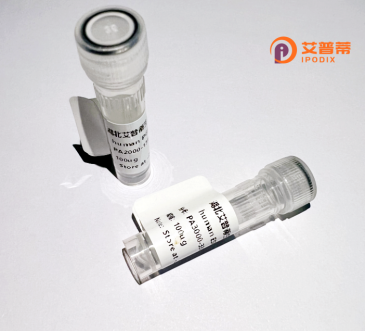
| 纯度 | >90%SDS-PAGE. |
| 种属 | Human |
| 靶点 | ARL4C |
| Uniprot No | P56559 |
| 内毒素 | < 0.01EU/μg |
| 表达宿主 | E.coli |
| 表达区间 | 2-192aa |
| 氨基酸序列 | GNISSNISA FQSLHIVMLG LDSAGKTTVL YRLKFNEFVN TVPTIGFNTE KIKLSNGTAK GISCHFWDVG GQEKLRPLWK SYSRCTDGII YVVDSVDVDR LEEAKTELHK VTKFAENQGT PLLVIANKQD LPKSLPVAEI EKQLALHELI PATTYHVQPA CAIIGEGLTE GMDKLYEMIL KRRKSLKQKK KR |
| 分子量 | 21.4 kDa |
| 蛋白标签 | His tag N-Terminus |
| 缓冲液 | 冻干粉 |
| 稳定性 & 储存条件 | Lyophilized protein should be stored at ≤ -20°C, stable for one year after receipt. Reconstituted protein solution can be stored at 2-8°C for 2-7 days. Aliquots of reconstituted samples are stable at ≤ -20°C for 3 months. |
| 复溶 | Always centrifuge tubes before opening.Do not mix by vortex or pipetting. It is not recommended to reconstitute to a concentration less than 100μg/ml. Dissolve the lyophilized protein in distilled water. Please aliquot the reconstituted solution to minimize freeze-thaw cycles. |
以下是3篇关于ARL4C的参考文献及摘要概括:
1. **"ARL4C regulates tumor invasion and metastasis through Wnt/β-catenin signaling in colorectal cancer"**
- **作者**: Kawase, S., Ishii, G., et al.
- **摘要**: 本研究揭示了ARL4C在结肠癌中通过激活Wnt/β-catenin信号通路促进肿瘤侵袭和转移的机制。实验表明,ARL4C高表达与患者预后不良相关,且通过调控EMT(上皮间质转化)相关基因驱动癌细胞迁移。
2. **"EGFR signaling promotes ARL4C expression to induce cancer-associated fibroblast activation in lung adenocarcinoma"**
- **作者**: Hashimoto, S., et al.
- **摘要**: 文章阐明了在肺腺癌中,EGFR信号通过转录因子Sp1上调ARL4C的表达,进而激活肿瘤相关成纤维细胞(CAFs),促进肿瘤微环境的重塑和肿瘤进展,为靶向治疗提供了潜在靶点。
3. **"Adenosine diphosphate-ribosylation factor-like 4C (ARL4C) modulates ciliogenesis and Hedgehog signaling during neurodevelopment"**
- **作者**: Mori, Y., Kondo, H., et al.
- **摘要**: 该研究发现了ARL4C在神经发育中的作用,证明其通过调控纤毛形成影响Hedgehog信号通路活性,进而参与神经元分化和脑形态发生,提示ARL4C缺陷可能导致先天性发育异常。
4. **"ARL4C interacts with ARNO to coordinate vesicular trafficking and cell migration"**
- **作者**: Matsumoto, F., et al.
- **摘要**: 文献揭示了ARL4C通过结合Arf鸟苷酸交换因子ARNO,调控细胞膜运输和细胞骨架动态变化,从而影响细胞定向迁移,为ARL4C在肿瘤转移中的功能提供了分子机制解释。
以上研究涵盖了ARL4C在癌症、发育及细胞生物学中的多重功能,重点关注其信号通路调控及病理生理意义。
ARL4C (ADP-ribosylation factor-like protein 4C) is a member of the ARL family, a subgroup within the RAS superfamily of small GTP-binding proteins. It plays a role in membrane trafficking, cytoskeletal reorganization, and cellular signaling. Unlike many ARL proteins, ARL4C is primarily regulated at the transcriptional level rather than post-translationally. Studies highlight its involvement in cell migration, proliferation, and vesicle transport, particularly during development. ARL4C expression is elevated in embryonic tissues but markedly reduced in most adult organs, suggesting its importance in developmental processes.
Notably, ARL4C is reactivated in pathological conditions, especially cancers. It is overexpressed in various malignancies, including lung, colorectal, and hepatocellular carcinomas, where it promotes tumor progression, metastasis, and drug resistance. Mechanistically, ARL4C interacts with effectors like Arfaptins and influences signaling pathways such as Wnt/β-catenin, mTOR, and ERK, driving oncogenic behaviors. Epigenetic factors, including EZH2-mediated histone modifications, and microenvironmental cues like inflammation or hypoxia, often upregulate its expression in tumors.
Due to its cancer-specific activation and functional roles, ARL4C is emerging as a potential therapeutic target. Preclinical studies suggest that inhibiting ARL4C or its downstream effectors could suppress tumor growth and invasion, though clinical validation remains ongoing. Its dual roles in development and disease make ARL4C a compelling subject for both basic and translational research. (297 words)
×